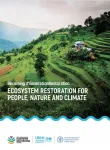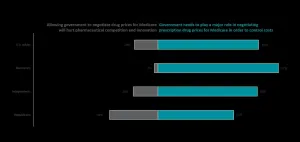(Press-News.org) Facing the triple threat of climate change, loss of nature and pollution, the world must deliver on its commitment to restore at least one billion degraded hectares of land in the next decade - an area about the size of China. Countries also need to add similar commitments for oceans, according to a new report by the UN Environment Programme (UNEP) and the Food and Agriculture Organization of the UN (FAO), launched as the UN Decade on Ecosystem Restoration 2021-2030 gets underway.
The report, #GenerationRestoration: Ecosystem restoration for People, Nature and Climate, highlights that humanity is using about 1.6 times the amount of services that nature can provide sustainably.
That means conservation efforts alone are insufficient to prevent large-scale ecosystem collapse and biodiversity loss. Global terrestrial restoration costs - not including costs of restoring marine ecosystems - are estimated to be at least USD 200 billion per year by 2030. The report outlines that every 1 USD invested in restoration creates up to USD 30 in economic benefits.
Ecosystems requiring urgent restoration include farmlands, forests, grasslands and savannahs, mountains, peatlands, urban areas, freshwaters, and oceans.
Communities living across almost two billion of degraded hectares of land include some of the world's poorest and marginalized.
"This report presents the case for why we must all throw our weight behind a global restoration effort. Drawing on the latest scientific evidence, it sets out the crucial role played by ecosystems, from forests and farmland to rivers and oceans, and it charts the losses that result from a poor stewardship of the planet," UNEP Executive Director, Inger Andersen, and FAO Director-General, QU Dongyu, wrote in the report's foreword.
"Degradation is already affecting the well-being of an estimated 3.2 billion people - that is 40 percent of the world's population. Every single year we lose ecosystem services worth more than 10 percent of our global economic output," they added, stressing that "massive gains await us" by reversing these trends.
Ecosystem restoration is the process of halting and overturning degradation, resulting in cleaner air and water, extreme weather mitigation, better human health, and recovered biodiversity, including improved pollination of plants. Restoration encompasses a wide continuum of practices, from reforestation to re-wetting peatlands and coral rehabilitation.
It contributes to the realization of multiple Sustainable Development Goals (SDGs), including health, clean water, and peace and security, and to the objectives of the three 'Rio Conventions' on Climate, Biodiversity, and Desertification.
Actions that prevent, halt and reverse degradation are necessary to meet the Paris Agreement target of keeping global temperature rise well below 2 degrees Celsius.
Restoration, if combined with stopping further conversion of natural ecosystems, may help avoid 60 percent of expected biodiversity extinctions. It can be highly efficient in producing multiple economic, social and ecological benefits concurrently - for example, agroforestry alone has the potential to increase food security for 1.3 billion people, while investments in agriculture, mangrove protection and water management will help adapt to climate change, with benefits around four times the original investment.
Reliable monitoring of restoration efforts is essential, both to track progress and to attract private and public investments. In support of this effort, FAO and UNEP also launch today the Digital Hub for the UN Decade, which includes the Framework for Ecosystem Restoration Monitoring.
The Framework enables countries and communities to measure the progress of restoration projects across key ecosystems, helping to build ownership and trust in restoration efforts. It also incorporates the Drylands Restoration Initiatives Platform, which collects and analyses data, shares lessons and assists in the design of drylands restoration projects, and an interactive geospatial mapping tool to assess the best locations for forest restoration.
Restoration must involve all stakeholders including individuals, businesses, associations, and governments. Crucially, it must respect the needs and rights of Indigenous Peoples and local communities, and incorporate their knowledge, experience and capacities to ensure restoration plans are implemented and sustained.
INFORMATION:
NOTES TO EDITORS
About the UN Decade on Ecosystem Restoration
The UN Decade on Ecosystem Restoration 2021-2030 is a rallying call for the protection and revival of ecosystems all around the world, for the benefit of people and nature. It aims to halt the degradation of ecosystems and restore them to achieve global goals. The United Nations General Assembly has proclaimed the UN Decade and it is led by the United Nations Environment Programme and the Food and Agriculture Organization of the United Nations. The UN Decade is building a strong, broad-based global movement to ramp up restoration and put the world on track for a sustainable future. That will include building political momentum for restoration as well as thousands of initiatives on the ground.
About the UN Environment Programme (UNEP)
UNEP is the leading global voice on the environment. It provides leadership and encourages partnership in caring for the environment by inspiring, informing and enabling nations and peoples to improve their quality of life without compromising that of future generations.
About the Food and Agriculture Organization of the United Nations (FAO)
The Food and Agriculture Organization (FAO) is a specialized agency of the United Nations that leads international efforts to defeat hunger and transform agri-food systems, making them more resilient, sustainable and inclusive. Our goal is to achieve food security for all and make sure that people have regular access to enough high-quality food to lead active, healthy lives. With over 194 Members, FAO works in over 130 countries worldwide.
June 3, 2021 - LA JOLLA, CA--Mining the world's most comprehensive drug repurposing collection for COVID-19 therapies, scientists have identified 90 existing drugs or drug candidates with antiviral activity against the coronavirus that's driving the ongoing global pandemic.
Among those compounds, the Scripps Research study identified four clinically approved drugs and nine compounds in other stages of development with strong potential to be repurposed as oral drugs for COVID-19, according to results published June 3 in the journal Nature Communications.
Of the drugs that prevented the coronavirus from replicating in human cells, 19 were found to work in concert with or boost the activity of remdesivir, an antiviral therapy approved ...
MIT researchers have created the first fiber with digital capabilities, able to sense, store, analyze, and infer activity after being sewn into a shirt.
Yoel Fink, who is a professor of material sciences and electrical engineering, a Research Laboratory of Electronics principal investigator, and the senior author on the study, says digital fibers expand the possibilities for fabrics to uncover the context of hidden patterns in the human body that could be used for physical performance monitoring, medical inference, and early disease detection.
Or, you might someday store your wedding music in the gown you wore on the big day -- more on that later.
Fink and his colleagues describe the features of the digital fiber in Nature Communications. Until now, electronic fibers ...
The number of people engaging with life-enhancing cardiac rehabilitation clinics has declined during the pandemic, according to a BMJ clinical update which makes the case for more home-based and virtual alternatives.
Before the covid-19 pandemic, 100?000 people were admitted to hospital with heart attacks and approximately 200?000 were diagnosed with heart failure annually in the UK. There was a 40% decline in the number of patients admitted with heart attacks (acute coronary syndromes ) in 2020.
Cardiac rehabilitation is crucial to helping people who have encountered a heart attack or heart failure have a better quality of life. Now, a new review, undertaken by cardiac rehabilitation experts based at the ...
WASHINGTON, DC - JUNE 3, 2021 -- A new West Health/Gallup survey finds nearly all Democrats (97%) and the majority of Republicans (61%) support empowering the federal government to negotiate lower prices of brand-name prescription drugs covered by Medicare. Overall, 8 in 10 Americans prefer major government action to control prices over concerns about it hurting innovation and competition from the pharmaceutical industry. The results come from a nationally representative poll of more than 3,700 American adults.
While President Joe Biden, Democrats in Congress and former President Donald Trump have called for such negotiation, ...
If you have ever tried to chip a mussel off a seawall or a barnacle off the bottom of a boat, you will understand that we could learn a great deal from nature about how to make powerful adhesives. Engineers at Tufts University have taken note, and today report a new type of glue inspired by those stubbornly adherent crustaceans in the journal Advanced Science.
Starting with the fibrous silk protein harvested from silkworms, they were able to replicate key features of barnacle and mussel glue, including protein filaments, chemical crosslinking and iron bonding. The result is a powerful non-toxic glue that sets and works as well underwater as it does in dry conditions and is stronger than most synthetic glue products now on the ...
People who use methamphetamine are more likely to have health conditions, mental illness, and substance use disorders than people who do not use the drug, according to a new study by researchers at the Center for Drug Use and HIV/HCV Research (CDUHR) at NYU School of Global Public Health. The findings are published in the Journal of General Internal Medicine.
The use of methamphetamine--a highly addictive and illegal stimulant drug--has increased in recent years, as have overdose deaths. Methamphetamine can be toxic for multiple organs including the heart, lungs, liver, and neurological system, and injecting the drug can increase one's risk for infectious diseases.
"Methamphetamine can complicate the management of existing chronic ...
A new study in the journal Sleep finds that increased evening screen time during the Covid-19 lockdown negatively affects sleep quality.
During the lockdown period in Italy, daily internet traffic volume almost doubled compared to the same time in the previous year. Researchers here conducted a web-based survey of 2,123 Italian residents during the third and seventh week of Italy's first national lockdown. The survey ran in the third week of lockdown (March 25th - 28th, 2020) and evaluated sleep quality and insomnia symptoms, using the Pittsburgh Sleep ...
A study published in the journal Pediatrics shows the combination of two early reading programs had positive effects on preschool students entering kindergarten in Cincinnati Public Schools over a three-year period.
The two early reading programs are: Reach Out and Read, through which children receive a new book and guidance about reading at home during well-visits from newborn through age 5; and Dolly Parton's Imagination Library, which mails new books to the child's home once a month from birth through age 5. Each of these is well-established at Cincinnati Children's Hospital Medical Center and across the nation.
"With this early study, we suggest that when combined and sustained, ...
CHAMPAIGN, Ill. -- Many species of ground-dwelling beetles, ladybugs, hoverflies, damsel bugs, spiders and parasitic wasps kill and eat pest species that routinely plague farmers, including aphids and corn rootworm larvae and adults. But the beneficial arthropods that live in or near cropped lands also are susceptible to insecticides and other farming practices that erase biodiversity on the landscape.
A new study reveals that beneficial arthropods are nearly twice as abundant and diverse in uncultivated field edges in the spring as they are in areas that ...
A University of Birmingham-led study of over a thousand dental professionals has shown their increased occupational risk of SARS-CoV-2 infection during the first wave of the pandemic in the UK.
The observational cohort study, published today (3 June 2021), in the Journal of Dental Research, involved 1,507 Midland dental care practitioners. Blood samples were taken from the cohort at the start of the study in June 2020 to measure their levels of antibodies against SARS-CoV-2, the virus that causes COVID-19.
The team found 16.3% of study participants - which included dentists, dental nurses and dental hygienists - had SARS-CoV-2 antibodies, compared to just 6% of the general population at the time. Meanwhile, the percentage of dental ...






